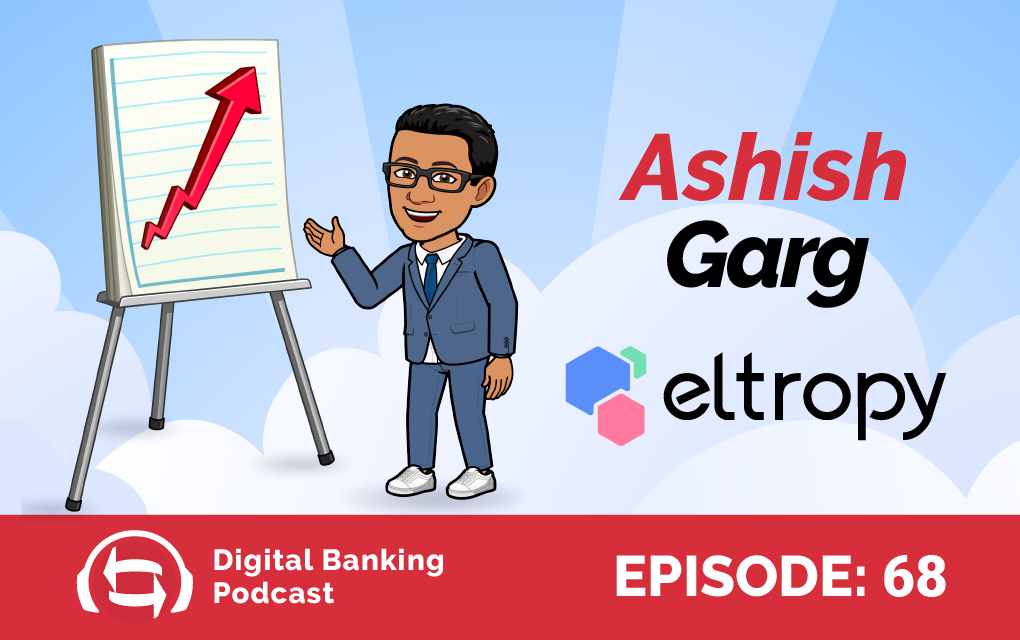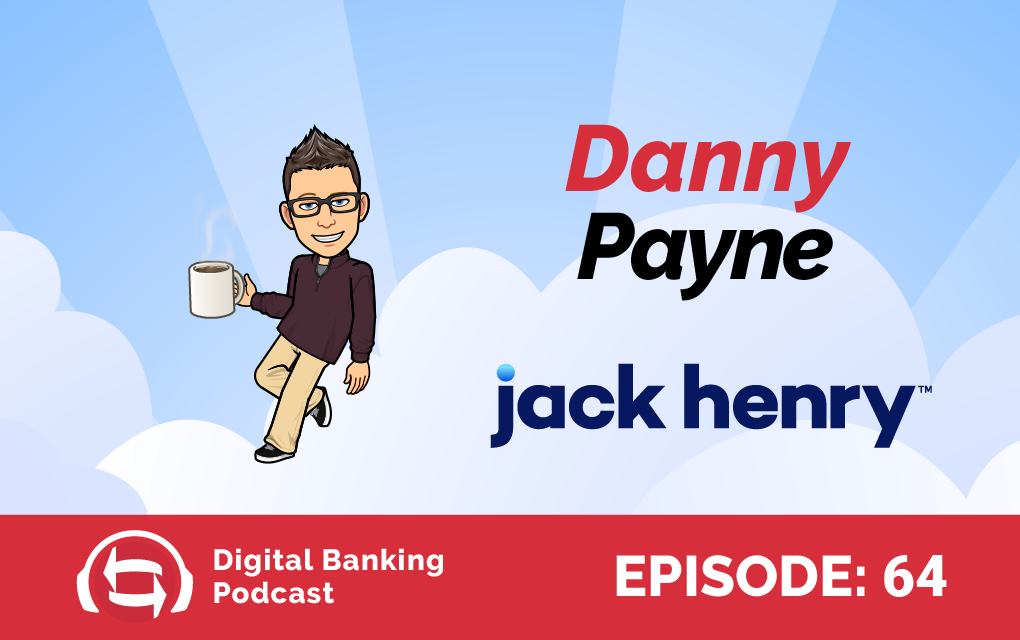[00:00:00]
Josh DeTar: Welcome to another episode of the
Digital Banking Podcast. My guest today is Michael Bank, the Co-Founder of Blip Labs. Having a grandfather in medical research and having done two summers in medical research himself, Michael was always drawn to the noble goal of helping people. In landing a job at PNC, fresh outta college, working with community FIs,
[00:01:49] one thing became kind of clear to him, though, while he loved the idea of helping people physically through the medical field, he actually had an even greater passion for helping people with their financial health. He said even working in banking, managing his own personal finances, felt like a second job.
[00:02:07] And if he felt that way, he had to imagine that millions of other Americans felt that same way, and as a 30-year-old, you know, Michael represents, in many ways, the next generation of
consumers that really love to challenge the old guard. So, Michael, I’m really excited to talk to you about a handful of different topics today.
[00:02:27] Welcome to the podcast.
[00:02:28]
Michael Bank: Thank you so much for that intro, and thank you so much for having me on today, Josh. I really appreciate it.
[00:02:33]
Josh DeTar: Yeah. So, you know, I have to clarify, I did ask for your permission before sharing your age before we started recording, but, you know, I felt like that was an important tidbit and one of the reasons why I’ve been really looking forward to having you on the show as a guest is, you know, for those of you who have listened to our podcast in the past, and maybe if you’re new to listening to us, go back and listen to an episode with Christian Trummer and Sahil from the George Washington University Credit Union Initiative.
[00:03:02] So, one of the things that we talked about in that podcast was how, you know, they were a group of college students that were looking to start a de Novo credit union out of George Washington University and had been facing a lot of headwinds. And I, I kind of made a comment in that podcast, and in some subsequent things we’ve done with them that, you know, I find it interesting that this group of college students who are obviously extremely bright, very motivated, very passionate, are plugged into the new age of tech and what consumers are looking for.
[00:03:32] You know, they kind of made the noble decision to say, “Hey, we could go start a FinTech to try and disrupt community financial institutions. Go get a bunch of Silicon Valley VC money, scale this thing like crazy to consumers, build a house of cards that ultimately doesn’t do any good for the communities that we live and work in.
[00:03:50] But who cares? We’re gonna sell it for a billion dollars, buy a yacht, and be sipping, you know, margaritas on a beach at 30.” And instead, they decided to start a credit union, and something that they felt was actually gonna give back to, especially their specific community at the George Washington University.
[00:04:06] And so, I felt like that was a really interesting story of how, you know, this group of, you know, newer consumers decided to do something like start a credit union. And then we talked about, on the other end of the spectrum, you know, they could have just gone and done a competing FinTech to traditional finance.
[00:04:22] And what I find really interesting about you, Michael, is that you’re kind of the in-between of the two, right? You said, “Hey, I really love the community financial institution model, I really see that there’s an opportunity for us to do better about helping everyday Americans and especially the younger generations, like, understand their finances, their money, and how to do simple little things like pay bills.”
[00:04:47] And so, you said, you know, “I want to split the difference and I’m gonna start a FinTech to work with the community FIs.” So, anyway, I just, I wanted to give some of that background about you ’cause I think that’s gonna have a big impact on kind of how you look at and perceive things in this conversation today.
[00:05:04] So, I mean, maybe I would wanna start with that, right? So, like I said, you know, you kind of represent this younger demographic. You know, one of the things that made you start thinking, “Hey, I think we need to make some changes in the way we’re doing things in the financial world today.”
[00:05:20]
Michael Bank: Yeah, that’s a great, a great question, Josh, and thanks again for that background and, and context. As part of kind of this newer, younger guard, right? Like, I am surrounded constantly by seeing changes in technology, right? I’m able to order food and have it delivered to my door within several minutes, right?
[00:05:41] And so, I’m able to log in and watch any show or movie that I want anytime, you know, day or night. But what has kind of lacked is innovation from the financial side of things, right? And so, as a younger individual, I found my friends, found people of our age demographic have seemed to find that we’re able to manage our, our lives through the use of technology in a really, you know, impactful way to streamline our lives,
[00:06:12] but in a financial sense, it has kind of lagged behind. And so, that’s really kind of how, you know, I see it from that perspective and wanting to kind of bring financial improvements to the world that have been seen in other types of categories of digital or technological advancements. And so, I guess broadly, that’s at least how I think about it and wanting to, you know, start a financial technology company to help bring the financial industry up to that kind of modern standards from the perspective of financial management because that’s ultimately what people have come to expect from their day to day lives.
[00:06:53] And so, you know, that’s something that I’m really, personally interested in, and, and, again, rationale behind, you know, wanting to do what I’m doing today.
[00:07:01]
Josh DeTar: Yeah, I think that’s what’s really interesting about, you know, your generation, my generation, we represent folks who grew up kind of with both, right? Little to no technology and tons of technology, right? I mean, I can still remember having to get into a car, go to drive to, you know, McDonald’s to get a burger kind of thing.
[00:07:24] But I also know the world where I can just say I’m feeling a little lazy and I’m gonna Uber eats that thing. And, you know, the generations coming up are really all in the tech world, and kind of the generations that came before us, again, have balanced a little bit more of both, but spent more time in the not having tech realm.
[00:07:47] So, you know, one of the conversations that comes up a ton in this podcast is this idea of digital transformation, and, you know, you kind of hit it on the head of this digital transformation is not just happening in banking, right? It’s, it’s happening all around us. So, you know, from your perspective, what are the types of things that you’re seeing that are influencing consumers, especially in those younger demographics that, let’s face it, community financial institutions need to attract?
[00:08:18] You know, what are the things that you’re seeing in the changes in technology that are driving some of these kind of expectations from them, from the banking world?
[00:08:26]
Michael Bank: Yeah, it’s a good question, and I think, you know, the kind of initial model was to take a lot of the in-person type of banking experience or even, you know, traditional web-based banking experience and just try to, like, morph that into work for a mobile-friendly type of banking experience.
[00:08:49] And it really, it really doesn’t work, you really need to have more kind of like a ground-up thought through strategy to a digital banking experience, from the conversations, you know, that, that I’ve had with people, and a lot of what that looks like is doing what people are used to doing, but in a much more native,
[00:09:10] financial way. So, really being able to embed yourself as the kind of financial partner as opposed to just kind of taking a PDF version of what you had on a, on a, you know, a website and putting that into mobile experience because that’s not really going to be as much of a digitally native experience.
[00:09:29]
Michael Bank: And so, kinda bringing it back to the point I was kind of alluding to or touching on before, is that people have come to really expect this digitally native experience and everything that they do. And so, you need to really have a cohesive, um, you know, experience from the ground up that allows people to manage their money all in one place and allows them to understand what their inflows and what their outflows are of their money and, and broadly understand their financial picture, and really be able to, you know, help them improve that financial picture with different, you know, insights and different things that can be done, you know, at the institution level with that data.
[00:10:10] And I think that those are, you know, happy to dig more into this, but those are really, at least conceptually, how I, you know, how I think about it in conversations that I’ve had with people in the industry that it really, this, this concept of digital transformation really can’t just be a copy paste from, like, a old website to a mobile phone experience,
[00:10:31]
Michael Bank: it really needs to be something that is thought through from the ground up and really designed with digital in mind, you know, as kind of that initial tool for individuals to use.
[00:10:41]
Josh DeTar: Yeah, you know, you made a comment to me before we started recording about how, you know, what excited you about tech and, like, why you got into tech and made the move from even the stop process of, you know, the medical field and then into banking and then, you know, kind of this foray into tech, um, you said that it was because you really liked how tech could actually impact people’s lives at scale and do it more broadly.
[00:11:06] And so, being able to actually create these, you know, really engaging experiences or, you know, simplifying operations or tasks or helping people be better at certain things like, you know, financial wellness, being able to do that with technology at scale was something that was pretty exciting to you, and I think that’s what’s interesting when you talk about this concept of digital transformation.
[00:11:30] I had a guest on a little while ago, Jeff Keltner from Upstart, and he made a similar comment to you about, you know, he said they go in and we, they talk to financial institutions about digital transformation, and they go, “Well, yeah, we used to ask our members to fill out, you know, this piece of paper with their information.
[00:11:50] And now we hand it to ’em on an iPad, and they get to fill it out on an iPad. So, we’ve gone through digital transformation.” And he was like, “Yeah, no, that’s not, no, we’re not on the same page here, like, you took a physical form and you put it on an iPad. So, yes, now you have a digital form, but it wasn’t a digital transformation.
[00:12:08] Like, did they even need to fill out the form in the first place? What if the form could be auto-filled? What if the form even needed to be asked because data was already present if we just integrated the form to another system or data repository, like, that’s where we start to take transformation, and that’s even only the beginning.”
[00:12:25] So, for somebody like yourself, you know, what do you think about those types of things?
[00:12:31]
Michael Bank: Yeah, you brought up a great point and, uh, you know, it’s, it’s really about using this tra, this word transformation as a tool or a platform to be able to utilize the data in, in insightful way and to be able to automate a lot of processes, right? So, from a bill pay perspective, at least, a lot of the initial onboarding that has traditionally been required has been very manual, right?
[00:12:56] So, there’s a lot that can be done in that space to help automate that experience for individuals, there’s a lot that can be done to help people better understand when they should be, you know, potentially refinancing a mortgage or when they should be, you know, looking to have, you know, student loans, a lot of different type of information.
[00:13:15] And so, to me, the transformation efforts are not, I like that iPad example, is, does that form even need to be there in the first place? Is there a way we can prepopulate that type of information for that end user? And for me, a lot of what technology does, and, and we talked about this before, the podcast is using this tool for, for good and to help improve people’s lives, to help automate people’s lives, and to help aggregate information automatically.
[00:13:45] And so, those are all things that I think, you know, an effective digital transformation strategy, um, needs to be able to actually employ in order to be successful.
[00:13:58] Can I ask you kind of a loaded question? Sure.
[00:14:01] Why do you care, right? Like, as, as somebody who has all of these different FinTech’s options, you know, you could go open an account with SoFi, you could go get your mortgage through Rocket Mortgage, like, you could do all of these granular products through all of these FinTechs that have been built from the ground up, digital-first,
[00:14:20] like, why does somebody your age even give a crap about a community financial institution, a credit union, or community bank sticking around? Why do you feel like that’s actually important to continue to empower? Like, where did that desire come from? I have to imagine it’s more than just, like, you have this desire to see, you know, good happen for communities. Like, why do you feel like community FIs are the answer to that, I guess?
[00:14:47]
Michael Bank: Yeah, again, they’ve been around for many, many years, they are already good at the business of banking, they have bank charters, there’s thousands of them that already exist, and where there maybe laggards is on the technology front, as opposed to the other way around for certain FinTech companies who have to build, you know, from scratch, which there’s something certainly to be said from that experience as well.
[00:15:16] But I think that ultimately what an end user, a customer, a member wants is an experience that is all-encompassing, right? And so, that way, they can manage all of their financial health, all of their financial picture, I should say, in one centralized location. As opposed to just, you know, signing up for one specific FinTech company that has, you know, just as mortgages or something like that, or just as loan refinancing.
[00:15:43] They want to be able to go to a centralized place that can manage all of their money, not just for today but for the future as well. And so, it’s something that is important to me because I, you know, you had mentioned this earlier around, like, my grandfather, and I had previously been in, in the healthcare space for a brief stint and realized that I still wanted to help people, but in a different way,
[00:16:09] and, you know, given that there are thousands of these financial institutions that already exist today, I don’t wanna see them go away, I want to be able to empower them to be able to offer products and services to their customers that ultimately can help save them, save their customers money, make them all money,
[00:16:27] and again, that’s all, you know, really important to me specifically, and seems like an easier path or avenue to pursue, maybe, than trying to go the other way around and getting a bank charter, right? When these financial institutions have been operating for a long time and, and know what they’re doing from a banking perspective.
[00:16:46]
Josh DeTar: Yeah, it’s a good point, you know, we see that statistic, it comes up year after year, after year after year, and it doesn’t seem to change a ton, and it’s that if you look at the average US consumer, you know, they want their primary financial institution to be a community FI, and they may not know that what they want as a community FI, but when they’re surveyed time and time again, you know, what they say they’re looking for out of their primary financial institution is somebody who understands them that treats them like a human, that thinks of them as a person, not a number,
[00:17:17] and, you know, they kind of self-select a lot of the qualities that make up a community financial institution, even if they don’t necessarily know what a credit union is, for example. So, they say time and time again they wanna do business with them, but when they get asked why they don’t or why they’re with, maybe, a mega-bank or a FinTech
[00:17:34] the answer is pretty unequivocally because of the tech, right? And I think this goes back to what you were talking about earlier with, like, Uber Eats, right? I mean, we have gotten to the point where we’re so driven by convenience that I will pay more than the hamburger costs to have it delivered to me because I can, and I don’t have to get off the couch than just getting off the couch and going, getting the hamburger myself, right?
[00:18:02] So, like, we as a society have become so insanely driven by convenience and experience that even when it comes to something as, like, foundationally important, as our financial health, convenience can win, right? So, I think a lot of times that’s why we see the technology wins, and I, I really appreciate the point that you make that, you know, I tend to agree with you, right?
[00:18:27] I think that it’s a lot easier for a community financial institution that’s culture is rooted in community and service and helping people to get good technology through partners than it is for a technology company to convince people that they are at their core what a community financial institution is, right? Let alone the whole, like you were saying, just getting a banking license and going through the regulatory hurdles.
[00:18:55]
Michael Bank: Yeah, no, there’s no reason why, again, we’re using a lot of food examples here, which is making me hungry now, but like, there’s no reason why we can’t, you know, have our cake and eat it too, right? Why not bring the community banks, the regional banks that have been around for a long time, they understand the business of banking and people, to exactly your point,
[00:19:13] when the services are conducted, people want that relationship, they don’t wanna feel like a number. So, why not kinda marry that up with the digital technology, you know, that can be presented and can be available to them, to really kind of create the best of both worlds where you have that institution that knows how to do banking, they know how to do relationships, and then on top of that, have all of the digital tools and technologies that some of their peers may have that prevent individuals or members or customers from wanting to sign up with them.
[00:19:46]
Josh DeTar: Yeah, you know, that creates an interesting, an interesting problem, right? Because for community financial institutions to do that, for them to be very competitive with the tech, they really have to, you know, build buyer, partner, right? Build is very difficult, especially if you’re trying to be really good at being a community financial institution, especially if you’re on the smaller side of things, like, building all of this technology internally is next to impossible.
[00:20:15] Buying is also probably out of the question for very similar reasons, right? So, a lot of times, what that means is that you’re kind of forced into partnering with tech companies to be able to, you know, like you said, empower them to do more in tech and to be more competitive in tech.
[00:20:31] You have to bear with me on this, you know, one of the things that I try really, really hard to do, and I make this comment multiple times on lots of episodes, you know, we really don’t want this to turn into a sales tool where people are just coming onto our podcast to pitch products, and, you know, we really want this to be about thought leadership and being able to have open long-form conversations about the things that are really important in our industry.
[00:20:54] But this might sound a little salesy, so that’s why I say get, bear with me, you know, I had this conversation recently with the CEO of one of our credit union customers, and I had this conversation with somebody at Financial Brand yesterday in Las Vegas, and it’s this notion that, you know, a lot of times we get attracted to sometimes the bigger, more established, the, you know, bigger tech players in the space and sometimes shy away from the younger, newer, smaller companies led by younger, newer people to the industry,
[00:21:30] and, you know, I think I’ve used this example in the past before, you know, we had a customer once, it was telling me a story of how they had a technology company come in to pitch them, and it was two young guys who showed up, looked like they hadn’t slept all night, like, their hair was a mess,
[00:21:45]
Josh DeTar: they were in jeans and t-shirts and looked like they’d been up all night coding. And the financial institution was like, “What did we get ourselves into? Like, these guys don’t even know what they’re doing, they can’t even show up properly for a meeting.” Phenomenal tech, long story short, ended up being an incredible relationship for this FI.
[00:22:01] They have some really cool tech that other people didn’t have access to because they were willing to take a risk on that. But, you know, a lot of times you see, you know, financial institutions walk past the small booth in the corner at the conference or pass up on the new company because they’re like, “Oh, you know what? You only have, you know, zero or one customer in our space and we really need to see you have 50 customers before we’ll sign with you,” and things like that.
[00:22:25] But when we’re talking about this, you know, needing to be reliant on a partner, needing to be able to move fast, needing to be able to meet the needs and expectations of especially younger generations, sometimes you gotta take a risk, sometimes you gotta go pick that small company, that scrappy young group of people who really wants to make a change, make an impact, and deliver some cool stuff.
[00:22:45] And I, I think that’s one of the things I find really interesting about our industry is how, I, I think, you know, again, this is being a little blunt with the comment you made earlier, right? Like, sometimes we see the problem of the old guard is, you know, this is how we do it, this is how we’ve done it, we don’t touch new, risky things.
[00:23:03] I get it. We have to be a cognizant of regulation compliance, we do have to be careful because we are handling people’s money, but at the same time, we have to look for ways to take calculated risks, and sometimes taking a calculated risk of maybe implementing a new technology solution through, you know, a new, young, innovative company that may not have a proven track record in our space can be a really cool solution to that problem.
[00:23:31]
Michael Bank: Yeah, I mean, like, I certainly, uh, agree and echo the comments that you’re making, and, you know, a lot, a lot of the types of technologies that have been coming out are more iterations on existing or legacy types of technologies, and this is where the FinTechs have done a really great job of being able to create new and innovative clean sheet of paper ideas.
[00:23:58] And there’s no reason why a community FI or a credit union, you know, is not able to, you know, do something similar. I understand the, you know, regulations are slightly different, I understand the risk appetite is slightly different, but at the same time, you know, there is an opportunity to do something new, unique, and differentiated with your customers,
[00:24:24] and, you know, be the best way, or the only way I should say, to capture that newer generation is to do new things, right? And the utilize, again, I brought this point up previously, but utilizing that data in impactful ways is what is something that FinTechs have done a really interesting job with, and there’s, again, really no reason why just because a company has operated for a longer period of time that they should shy away or be scared of trying something that’s new or innovative or different. And so, I, I certainly echo with the comments you, you have.
[00:25:00] I’m glad you made that comment, I want to talk about that. So, you mentioned, you know, a lot of times the FinTechs do a good job of using the data to understand, you know, what are people expecting, what are the pain points that they have, how do I solve that in maybe a very specific or niche way? So, how do you recommend that, you know, community of financial institutions try and make some of these calculated risks, as well, right? Like, how does a community financial institution go about understanding, “Okay, what are the Michael Banks looking for? Like, how do I get them to do business with me instead of SoFi?”
[00:25:32] Yeah, again, like, really the, the, the way in which we see this operating is, uh, you know, from, from an end-user customer perspective, right, people are looking for these types of data sets now, the utilizing the data in, in, in interesting and impactful ways, like I said before. And, you know, the younger generation now expects that because they have gotten that comfortable type of experience from working with those FinTech-type companies already.
[00:26:03]
Michael Bank: So, from a customer or member perspective, you know, people already now have this expectation because FinTechs have done a good job of being able to build out data to be used in such a way that helps people improve their financial health and their, and their financial understanding. And so, again, we work directly with FinTech companies,
[00:26:25] We work directly with partner, with FIs, we work directly with community banks on trying to be able to unpack that data, to really be able to allow those customers to understand their inflows and their outflows of money because that’s ultimately, you know, you can’t determine how to appropriately allocate for a savings account or to a mortgage or to a kid’s college fund without really understanding what your inflows and outflows are on a monthly basis.
[00:26:55]
Michael Bank: And so, that’s something we’re really, really focused on, and working closely with our customers to be able to actually allow them or enable them to look at this data in such a way that’s differentiated from the way that they’re currently doing it to, again, not just improve the financial health of their customers, but also continue to be this tool or this resource where they can engage with their customers, you know, on a monthly, daily, weekly basis.
[00:27:22] You’ve made this comment a few times now, this idea of kind of having an aggregated, holistic financial picture, right? So, what does that mean to you, like, as a consumer, what are you looking for?
[00:27:36]
Michael Bank: Yeah. So, time and time again, you know, we’ve seen, and I personally have experience with this, just kind of like going to, you know, you know, X, Y, Z checking account, seeing a bank balance that’s there, and thinking that’s almost, like, my safe to spend amount of money on a, on, you know, for that given month, and not really factoring in what my
[00:27:56] obligations are from a debt perspective, which is kind of bringing it back to the point I was making before. And so, to me, that kind of aggregated experience captures my inflows of money on a monthly basis, it captures my outflows of money on a monthly basis, and ultimately helps me better understand how I can be allocating my money.
[00:28:19] So, not just being this tool to show an individual or customer or a member how much money I have in my account, but allowing that or enabling that individual to better understand how that money can be used and how that money is going to be spent throughout the remainder of the month because we’ve run into a lot of scenarios, and there are millions of people that struggle with this in this country where, you know, they have a certain amount of money in an account, and they’re not really understanding how, you know, that could be factored into specific monthly recurring subscriptions they have or different types of payments that they have to make throughout the remainder of the month.
[00:28:57]
Michael Bank: And so, really having this centralized place that allows people to understand what that inflow and outflow actually is, allows people to get that understanding of that financial picture and ultimately allows them to approve upon it over time.
[00:29:13]
Josh DeTar: What do you think that looks like long term? ‘Cause I’m with you in that, you know, some of the times I get a little bit frustrated with just how fragmented my financial picture is, right? Like, I think about, I have my credit union account that’s my primary account and I have auto loans through them.
[00:29:30] And then, you know, maybe I have another account for X, Y, Z and then maybe I have, if you’re in a case like me, a hundred bucks in, like, way too many institutions, so I can see what they’re doing from testing purposes. I’ve got all these different institutions that represent kind of the traditional financial institution model.
[00:29:47] Then I’ve got my investment accounts, then I have my crypto accounts, then I have, you know, my, like, wealth management accounts and things like my 529 for my son. And all of a sudden, I’m like, “Man, how do I look at all of this in one place and go, ‘Okay, this is what I’ve got, this is what I don’t have,
[00:30:07] this is what I have for the future, this is what I have for right now, like, this, this is my financial picture.'” In my mind, a part of me wants to say, “I’d love to be able to see all of that in one place,” but then does become too cluttered, like, how do you even create an interface that shows all of those things? And then you start thinking about, well, do I really want all of those services from a single provider?
[00:30:30] Maybe, maybe not. And if it’s not single providers, like, are all of these providers even gonna be willing to work together to quote, unquote aggregate into one centralized place? Like, from your experience or your own personal thoughts, what do you think consumers are looking for as we only get more and more complex and fragmented in the places we have our money?
[00:30:52]
Michael Bank: Yeah, I think, again, all the points you bring up are valid, and it’s kind of an interesting thought experiment as to what the future of this all kinda looks like as things get more and more fragmented, and my objective is to make things more and more aggregated, right? And from the perspective of an end user, again, for myself, I can speak for, I can speak with, you know, from a lot of other conversations that I have had, along with other financial institutions that we’ve had conversations with, which is really about trying to be that centralized place where people actually do manage their money.
[00:31:27] And it doesn’t necessarily need to be a place where all of your accounts are from that one institution, but it’s still really important for an individual to be able to see all of their accounts in one place, it actually even becomes a really strong marketing channel for that financial institution to be able to see what somebody has somewhere else
[00:31:48] because then it allows them to say, you know, “Hey, we noticed that you have this auto loan with this other institution you may wanna consider, you know, and here’s the rate you have it at, you may wanna consider switching it to us, here’s how much money you can save over the duration of that loan.” Right?
[00:32:02] So, there’s a lot that can be done, again, with that data from the perspective of actually, you know, outside of that financial relationship and outside of that financial institution. And customers really want that centralized financial picture. And this brings up kind of a, a separate point as, as well, around kind of automated finances and what that looks like in the future
[00:32:26] because you have one bucket of people that say, “I kind of wanna set everything up in my life and forget about it and put everything on autopay.” Well, the problem with that is then we run into scenarios where people don’t really have a good idea of what their monthly outflows are, and they’re typically overspending.
[00:32:42] On the flip side, you have people that say, “I wanna manage every little minute detail.” And then, everything is all over the place in your kind of example, right? And so, the future is kind of a combination of the two, which is, you know, at, at least from my perspective, I can say, really more in the way of automating a lot of this, but empowering the end user or the member or the customer to understand where all of this money should be allocated to, where it’s going to, and have that credit union, have that community bank be their advocate really, and be able to help them understand where that money should ultimately be going.
[00:33:20]
Michael Bank: And, again, can talk a lot about this, but that’s really gonna, at least broadly how I think about it and when I speak with other people how, you know, they think about the future and how they want their finances kind of aggregated in one place as well.
[00:33:33]
Josh DeTar: Yeah, I, you know, this is one of those, I don’t know, like, lay awake at night and think about things for me too, and, and I, you know, I’m just one single sample set, right? But I’m, I know myself better than, and I know the rest of the market, but if I think about myself, I’m really similar to what you were talking about, right?
[00:33:50] Like, there are a lot of things that I do, I just, I set up on autopay, you know, things that don’t change, but for example, I, I work in digital banking, like, I work in technology, I work in finance, and you know what? Every single month I still go to my actual local water utilities website to pay my water bill through them.
[00:34:12] Why? ‘Cause I wanna go and see what my water bill is, like, our little dudes, you know, epically long baths right now, taking up a ton of my water bill, like, is that causing an increase? I don’t, I don’t know why, that’s one of the ones that I’ve just, like, latched onto that I just refuse to set up on autopay, and I always wanna log in, I wanna look at, and so when I think about this whole
[00:34:30]
Michael Bank: But again, there’s no reason, there’s no reason why that community bank financial relationship that you have shouldn’t be able to say like, “Hey, Josh, we noticed that this bill from this provider is higher this month, like, you should look into why that’s the case.” Right?
[00:34:44] And then they really have your back, they’re engaging with you as a customer, and they’re thinking about, again, to that point, like, the data in a more impactful way and bringing things to your attention that otherwise you’re gonna left yourself to think about.
[00:34:58]
Josh DeTar: Yeah, man, exactly. That’s what, it’s, so, that’s my dilemma, right, is at what point are we able to kind of flip some of those scripts? And I think that’s where you were saying, you know, talking about, “Hey look, we have to think about digital transformation” is not just saying, you know, and I’m just, I’m only using the example ’cause we were talking about it, but like, you know, you can come to our institution to pay bills, and you’re like, “Okay, cool.”
[00:35:23] Did that really radically transform my life? I don’t know. Is it any faster or easier or more convenient for me to pay my bills there versus going bill or direct? Maybe, maybe not. Right? So, how do you then say, instead of just taking this and making it digital, like, is there a way we can actually transform that?
[00:35:44] And I think that was a great example, right? Like, what would probably get me to rethink about setting up my water bill for recurring is, like, I’m an Apple Watch junkie, how cool would it be if every month I got a little push notification on my watch that said, “Hey, Josh, your water bill was just made.”
[00:36:02] You know, FYI, just like I get my, you know, weekly activity report that shows me how many calories I burned each day in a nice little graph, like, “Hey, here’s the last 12 rolling months graph of what your water bill looked like, we noticed it spiked crazy, you might wanna log in and check that one out.” Right?
[00:36:17] “You got, you got a busted sprinkler in the backyard, or something, dude, what’s going And that’s where using a lot of the data, a lot of the technology, and then being able to, like you said, automate some of this stuff so it’s easier on me, it’s more convenient on me, but I’m also better informed, right? I think that’s where we have a lot of opportunity, personally.
[00:36:38]
Michael Bank: Yeah, we, so we certainly, I certainly agree with you and, you know, people are paying, you know, all adults are paying bills, they’re paying multiple bills per month, and it’s a really great way, you know, for a community bank, for a credit union to really be able to think about that relationship as more of, like, a true partner with their customer or with their members,
[00:36:59] and being able to, again, coming back to this point around using those date, the data in insightful ways, and you’re able to continue to engage with your customers. I’ve been using this word lately, banking on engagement, which is really, like, really trying to think about engaging with your customers through the banking experience,
[00:37:17] and the example that you’re bringing up with the sprinkler, again, is a perfect analogy or way in which that FIs can go about doing things like that.
[00:37:27]
Josh DeTar: Yeah, you know, we’ve talked about this in the podcast before too, in that, it, I think one of the struggles for community FIs is, it’s so ingrained in their culture to help and to be really good at understanding their consumers, right? I won’t name any names in case he doesn’t want me to, but I was literally having a conversation with a customer last night and, and he was talking about their average hold times for their call center, and their average call times,
[00:37:56] and he said, “You know, one of the things is we have a lot more call center staff than I think we probably should, and our hold times are longer than they probably should be because our call times are longer than they probably should be. But it’s because we have so ingrained in our culture of our institution that, like, whatever the member wants to talk about, like, we’re here to talk to ’em.”
[00:38:18] And so, they know those people really, really well, and they’ll be able to have that conversation with ’em, be like, “Oh, hey, Josh, you know, I noticed your water bill is a bunch higher than it usually is, and, like, do you have a broken sprinkler?” And so, they may be able to make those kinds of recommendations and things.
[00:38:34] But I, where I’m going with all this is, I think one of the apprehensions that our industry has is, like, what if you don’t have all the data, right, or, or what if you have incorrect data and you make a wrong assumption, or you make a wrong piece of advice? And I don’t know if I’ve used this example before or not, but I remember I signed up for one of the, like, FinTech PFVME services just to do some testing and, like, see what they were doing,
[00:38:59] and they had me, you know, plug in some of my information and stuff, and one of the things that they were really proud to show me was my net worth, and it was not even close. And, and it was because they just didn’t have my whole financial picture, right? But, you know, to me, I kinda laughed that off and was like, “Okay, I know that’s not my actual net worth.
[00:39:19] I just didn’t tell you about, you know, these investments or I didn’t tell you about my home property, or these things, maybe you didn’t ask, or maybe I just didn’t feel like volunteering that information.” Right? But so, you know, I think that’s one of the things I see is some of the apprehension from community financial institutions is, like, if I unleash a chatbot on my website and the chatbot starts making financial advice to Michael, but it doesn’t really know Michael and it makes some bad advice, or maybe just not the right advice or the best advice, was it really actually a good thing?
[00:39:57]
Michael Bank: Yeah, again, all fair points, and th, this is where, again, I was talking about more the future piece around, like, having that centralized place where you do have kind of all of the data in one centralized place, right, but I guess, you know, also in, in the more immediate term, in the near term, right?
[00:40:13] Like, we work very closely with all of our customers to ensure that we are providing the types of information that is most impactful or most relevant for their members and for their customers. So, there is, again, from, like, a chatbot perspective, which I see, like, going off the rails and making any type of recommendation that it wants, which may not be, you know, the right time, you know, the right recommendation at the right time.
[00:40:39] We still have, like, a very much of, like, a human element to, to the things that we’re doing in terms of working closely with, you know, partners and banks and financial institutions to ensure that, you know, where there are gaps in data, which certainly it does exist, that we’re still making the right types of recommendations at the right time.
[00:40:58]
Josh DeTar: Yeah. It’s, like, this has come up a few times recently, and I don’t know why, it just makes me laugh, but it, I keep thinking about, like, the bad robot, right? That, like, goes off the rails and, you know, you install this chatbot, and it starts to learn your behavior, and it starts to learn how you spend money.
[00:41:13] And then, you know, all of a sudden, it pops up and starts messaging you, and it’s like, “Michael, you are such a moron with your money, I’ve seen how much money you spend at Starbucks, like, dude, do you really need that third frappuccino today? Like, chill out on your Starbucks, good grief, could you be any more, you know, unintelligent with your money?”
[00:41:31]
Michael Bank: A drill, like a drill sergeant.
[00:41:32]
Josh DeTar: Yeah, and you’re like, “Oh my gosh, like, this is my credit union talking to me like this.” And the whole conversation was, like, who owns the liability of this chatbot going off the rails and, like, start cussing at members and telling ’em that they’re, you know, making bad decisions or something, like, where does it pick up this information and how does it start making these recommendations? How do you put guardrails in for that? But I don’t know, that’s just, that’s a funny conversation that I feel like is kind of a few times lately.
[00:41:57]
Michael Bank: Yeah, certainly don’t want that to be the case unless you’re the type of person that likes that type of feedback, I guess. But joking aside, yeah, no, again, the data can be used in a really impactful way, and I, the other thing that I’ll say is right now, you know, I bank with several different financial institutions, and I will get in the mail
[00:42:18] constantly things that say, like, “You should refinance your mortgage,” and I don’t even have a mortgage, right? So, right now, there’s already this element of setting out information, you know, or providing potential insights in a non-digital way that are not accurate as it stands today. So, from that perspective, we are utilizing the data in a way that would be able to say, for example, “We noticed that you have a mortgage with this other provider, and you should refinance it with us.” Right?
[00:42:47] And so, it’s actually, you know, taking that data and layering in the data that we do have and providing a positive outcome from it, and not just guessing at, you know, whether someone should or shouldn’t be refinancing a mortgage, for example.
[00:43:01]
Josh DeTar: Yeah, I think that’s one of the interesting things that I’m curious to see how that changes through the demographics and, you know, generations, right? Because, again, going back to, like, you know, you and I are kind of in that almost 50/50 world, right, of tech, no tech, the generations that came before us, maybe 80, 90% no tech,
[00:43:21] and, you know, the later stages of their lives, some of this tech and how much do they choose to actually use or adopt it. And then, the younger generations who know nothing but tech, right? Man, I don’t even, I mean, it’s wild how intuitive some of the new tech has gotten and is ingrained into, you know, the younger generations.
[00:43:39] Like, they just, it’s a part of their lives, right? So, when we look at kind of how each of those different generations think about use and have history with technology, I also wonder how much of a difference you’re gonna see in, you know, if somebody in their late seventies gets a piece of technology making up a wrong recommendation, right,
[00:44:04] or something like that versus a younger generation, like, are there expectations of, “Hey, you know what? Other tech gets this right, why are you getting this wrong? Like, this isn’t hard, somebody else got it right.” Or is it the other way around? I don’t know. I think I’d be curious to see what that actually looks like.
[00:44:24]
Michael Bank: Yeah, again, like, you know, banking is something that brings multiple different generations, you know, to the forefront, you know, all using the same experience at the same time, right? And so, that’s where, again, you know, I touched on this piece earlier, but a lot of this automation, automation is important.
[00:44:44] Because if you are, and I also brought up, I think Apple maybe earlier, it may have been before we were actually recording the podcast, but, you know, there’s a lot that, you know, Apple can do, for example, for a younger person to understand their software, for a middle-aged person to understand their software,
[00:45:01]
Michael Bank: and my grandmother is completely up to date, knows how to use her iPad, and her iPhone, like a win, just like I can. And so, I think there is an opportunity to be able to make the technology seamless, to be able to use, you know, across different demographics, different generations, and by automating a lot of, a lot of that in inappropriate way will, you know, allow certain people that maybe are not as technologically savvy to get ramped up to speed, and really get to understand what they should be doing
[00:45:32] because when there is a lot of manual input required, that’s where you typically lose people, both younger generations and older generations. So, again, being able to automate that and create this seamless UI/UX digital experience for, for a customer, is really, really important.
[00:45:49]
Josh DeTar: Yeah, actually, that’s a great point. I think, you know, if you’re listening to this podcast, you should totally check out a book by a gentleman, Steve Krug, called “Don’t Make Me Think.” And it’s talking about how to, you know, do user experience and specifically around technology in a way that makes people not think, right?
[00:46:10] This has been mindboggling to me, Michael, right, in that, so I have a one-and-a-half-year-old son now, and, um, you know, hey, right, wrong, or indifferent, we’ve, like, kind of tried to keep him away from technology as much as possible, like, away from the tv, away from phones and things like that. But when he interacts with technology, it is crazy how fast he figures out how to use it and do it.
[00:46:38]
Josh DeTar: Like, all the little learning toys that he has and things, they take longer for him to figure out than he already knows how to, he loves seeing pictures of, like, things that we’ve done as a family on our phones. He’ll grab it from you, and he already knows how to, like, zoom in and look at things, he’s one and a half years old, and he’s just like, I’ve sure seen us do it,
[00:47:00]
Michael Bank: Just ingrained into his DNA, just ingrained into his DNA.
[00:47:02]
Josh DeTar: it’s just so intuitive, like, he just thinks this is what I want to, like, peer into it, so I just spread it open to look into it, and it opens up and gets bigger, and he does it once, and it sticks, and he does it the next time without even thinking about it. And so, I think that’s a really, really important point as we start to think about this digital transformation within community financial institutions and trying to not just do things the way we’ve always done it, you know, you, sorry, I wanna make sure I used the same verbiage you used from earlier, you made a comment about,
[00:47:31] trying to look back through my notes about not just doing it the same way that we’ve always done it, right, and making sure that we start kind of fresh from the ground up instead of just trying to maybe tweak an old process, just start fresh. And so, as we start fresh with some of these things and say, all right, let’s just, this is the end state that we need to get to.
[00:47:55] Let’s take away all of the legacy baggage that we have, and let’s just take the learnings from it and say, how can we make this an experience that won’t make people think that they’ll just jump in and they’ll know how to do it? I think that’s something that’s gonna be really important is we look to kind of transform how people do banking.
[00:48:14]
Michael Bank: Yeah, I certainly agree and, and it really kind of comes full circle to the original points we made around this transformation effort and your example on the iPad PDF versus the paper document, right, which is if a financial institution wants to have a digital experience, I think that one of the, an interesting or unique way to think about it is, like, let’s think about this from the end goal perspective,
[00:48:42] like, what do we want that to look like, and what do we want that experience to be for our mender, for our members, you know, clean sheet of paper, if I were to be able to build that experience, what would that look like? And then, you know, be able to think about conceptually where there may be flaws, where there may be hangups, where there may be reasons why people are calling in these call centers for hours at a time to, to be able to improve those experiences and then build that experience that people actually want, right,
[00:49:09] as opposed to doing it the other way around, which is just trying to take what we’ve been doing from a digital perspective and kind of just mobilfy it, if that’s even a word. Because, because ultimately, that’s really not a digital transformation strategy, which kind of, I know we had made this point earlier, but really thinking about it from the perspective of how do we think about what our end goal is and what do we want that experience to be for our customers and for our members, and how do we ultimately go about achieving that in a digitally native, thoughtful, kind of unique and interesting and new way.
[00:49:44]
Josh DeTar: Can I ask you kind of the pie-in-the-sky question then of, you know, what do you think, you know, even the generations after you and I that come in, and that know nothing but epic levels of convenient tech, what do you think they’re ultimately gonna be looking for in financial services and the technology that helps them access financial services? Any predictions?
[00:50:06]
Michael Bank: We’ll have to ask your one-and-a-half-year-old this when he gets a little older, but yeah, I really think as things, you know, get more and more digitally native and, and I’m not talking about a banking perspective, I, I just mean broadly speaking, I think more and more gets taken out of the hands of consumers, and more and more is automated.
[00:50:26] And this is why I was bringing up that point before, it’s really about how can my financial institution help set me up for success in the future. And, you know, having me as a member when I’m young, understanding where I am, specifically as a person in my life, and how I am different from somebody else, how my wants, needs, desires are different, and how that institution can ultimately help me.
[00:50:54]
Michael Bank: Again, I know this has kind of been a theme, but using that data in a way that’s actually, you know, helpful to me as a consumer and how can we think about automating a lot of those features and functionality, but allow me to still have that ultimate control and oversight, I guess is the right word, as a member to kind of understand my financial health without me having to do all this manual legwork that, as a, you know, individual in today’s society I need to do from a banking perspective, but I don’t need to do when I manage the rest of my life.
[00:51:30]
Josh DeTar: You know, one of the other buzzwords that’s been coming up a lot lately, and I think we’re starting to see a lot of different companies come into the space and try and solve for is this idea of kind of hyper-personalization. So, do you feel like hyper-personalization and automation kind of go hand in hand and maybe this idea of
[00:51:49] if it’s hyper-personalized for you, it can be automated because we know you and what needs to be done for you, and it may be different than Josh. So, both of those tasks can run simultaneously automated, but be very different for each of us, but just with maybe some guardrails, like you say, around that so that if I decide I don’t want that automation to process, there’s checks and balances in place. Do you think that’s one of the things that we’re gonna see more of?
[00:52:15]
Michael Bank: Yeah, again, from a futurist perspective in me, like, I, that’s the world that, you know, I would personally be really interested in because so much of what I need to do, so much of a time suck is, you know, spent managing my own personal finances, and I don’t always necessarily have the right answers for, you know, where my money should be going.
[00:52:35] So, I want that help, but I also am different than my, you know, significant other, or I’m different from my neighbor, et cetera. And so, being able to, you know, I think use those insights in a way that is also paired with the automation is going to be more of what the future is. As a, as an example, like, today, I know that there are FinTech companies that are focused on
[00:53:00] providing, you know, advancements on your own pay salary, right? Like, if you’re an individual, you can go in, you can say, “Hey, I’m struggling to meet this month’s rent. I’m gonna need, you know, an advance on my, my salary, right, for this week.” Right? And you can get that, you can pay that back. But there’s no reason why that institution shouldn’t be able to see in advance, given your inflows and outflows of money, that you’re not going to meet that payment, right?
[00:53:25] That you’re not gonna have enough money in your account at the time. And they should say, “Hey, we noticed that you’re not gonna be able to facilitate this payment that you have coming due in three days. We’ve gone ahead and automatically fronted you that advance on your pay.” Right? Those are the types of automations that are gonna be customer specific, but would be really impactful to me as an individual and removes a lot of the manual legwork from me to have to do all of this stuff on a month-in and month-out basis.
[00:53:54]
Josh DeTar: Yeah. That kind of brings it back to what you were talking about at the very beginning, right, of some of the coolness of what technology can offer us is this opportunity to actually provide value and help at scale, and that is a, it’s a terrifyingly fascinating problem that we still have in America.
[00:54:14] Like, it actually astounds me, you know, how many people still use things like egregious payday lenders and, you know, different check cashing services and all of these different things that could be serviced by community financial institutions that actually care, that are actually putting an emphasis on the individual
[00:54:34] and I think by providing technology that makes access to some of those services easier, more efficient,yeah, to your point from earlier, like, we’re actually doing a lot of good, we’re actually, like, really helping people, and technology can help us do that at a scale that we can’t with brick and mortar.
[00:54:53]
Michael Bank: Yeah, certainly agreed, and that’s a future that I wanna live in, hopefully, your one-and-a-half-year-old wants to live in as well.
[00:55:00]
Josh DeTar: Yeah, I know, you know, it is one of the things that, you know, I don’t know, as a new parent into this world, like, it does change the perspective on that, right? And I think it’s one of the things that makes me that much more passionate about, and excited about being a part of this industry
[00:55:13] ’cause to your point, like, that’s the world I want my kid to grow up in, right? I want my kid to grow up in a world where he has access to some, look, I mean, money paying for things is not going anywhere, right? He’s gonna grow up in a world where he’s gotta have finances and manage that, and it’s a huge part of our lives.
[00:55:32] To quote my semi-less famous podcasting friend, Joe Rogan, um, you know, he made a comment once, it’s just kinda always stuck with me, and he said, “You know, money doesn’t buy happiness, but it does buy freedom.” And, you know, even just freedom from the stress of, like, “Oh gosh, am I gonna even be able to make my rent this month?”
[00:55:51]
Josh DeTar: And so, a community financial institution’s actually looking out for somebody and helping them with their finances is quite literally potentially helping them with freedom, like, that’s the world I want my son to grow up in, I want him to grow up in a world where somebody actually cares about that as opposed to just seeing his, you know, him as a way to generate revenue off of him at whatever cost that is to him.
[00:56:13] And so, community financial institutions really represent that for me. So, I think, you know, that’s one of the other reasons why I was just, I was really excited to have you on as a guest is it’s really cool to see, like, we were talking about earlier, like, you know, world’s your oyster, you still got a lot of years ahead of you, things to do, and you’ve chosen to do something
[00:56:34]
Josh DeTar: with this end goal of being able to help people, right? And looking at, you know, how can I just empower systems in place that are in place today, that have been in place for decades, that help people, like, how can I just help empower them to help people even more at more scale, faster, bigger, better. So, it’s really cool to see just that, that kind of new blood of people coming in with that same level of passion. I, I love seeing that in you.
[00:57:00]
Michael Bank: Well, thank you very much. Appreciate it. And we’re excited, I’m excited about what the future holds myself, as well.
[00:57:07]
Josh DeTar: Well, Michael, before I, uh, turn you back on your day, two final questions for you, sir. So, first off, where do you go to stay up to date on what’s happening in our industry?
[00:57:17] Yeah, good question. I’m not necessarily sure I have one specific place or one favorite tool. From, like, a newsletter perspective in the FinTech space, there’s something called This Week in FinTech, which provides a lot of really great insights, you know, if you’re a community FI and you wanna check out what’s going on in the FinTech world, there’s a lot going on there.
[00:57:37] And then, also just from, like, a more traditional banking news perspective, The Financial Brand has a great newsletter as well, and a lot of great webinars and podcasts that, you know, I check out to, to be able to stay up to date on local news, local trends and stuff going on in the industry.
[00:57:53]
Josh DeTar: Awesome. And then, uh, if people wanna learn a little bit more about you and Blip and what you guys are doing, and if they want to connect with you, how do they do that?
[00:58:02]
Michael Bank: Sure. You can find us on our website is tryblip.com, you can find us on Twitter, LinkedIn, @BlipLabs, you can reach out to me personally at michael@tryblip.com. I’m also on LinkedIn and Twitter as well.
[00:58:17]
Josh DeTar: I just, sorry, I have to laugh ’cause I have to say, I think this is your, here’s your sign that, you know, we have a co-founder of a company that is in his younger years when I think you’re the first person I’ve ever asked that question of, like, where can you find us? And one of your first answers was Twitter. So, I don’t know, I think, I feel like that’s a sign right there.
[00:58:36]
Michael Bank: Yeah, we’re across all different mediums and, um, we’ve got, we got a lot of attraction on there, so, yeah.
[00:58:43]
Josh DeTar: That’s awesome. Well, Michael, thanks so much for coming and being a guest on the Digital Banking Podcast.
[00:58:48]
Michael Bank: Of course, thank you so much for having me, appreciate it, and it has been great conversation, and look forward to continuing the conversation with you down the road, as well.
[00:58:56]
Josh DeTar: Awesome. Thanks, Michael.













